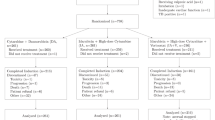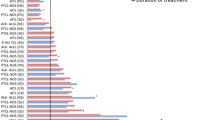Abstract
The current therapy for high-risk myelodysplastic syndrome (MDS) involves repeated cycles of the DNA demethylating agent 5-azacitidine (5-Aza), but combination treatments have been proposed to improve patient outcomes. We performed a phase Ib study to investigate the safety and tolerability of 5-Aza (75 mg/m2) combined with the histone deacetylase inhibitor panobinostat (PAN) in adult Japanese patients with MDS or chronic myelomonocytic leukemia (CMML). Eleven patients were enrolled; five received 20 mg PAN + 5-Aza and six received 30 mg PAN + 5-Aza. All patients in the 20 mg PAN cohort had MDS, while two in the 30 mg PAN cohort had MDS and three had CMML. All patients experienced ≥1 adverse event (AE) related to the study treatment, and five discontinued the study treatment because of AEs. One patient in each group exhibited dose-limiting toxicities: lung infection (PAN 20 mg + 5-Aza) and cellulitis (PAN 30 mg + 5-Aza). PAN exposure increased with ascending doses, and combination therapy did not affect PAN plasma trough concentrations. In summary, 20 or 30 mg PAN combined with 5-Aza was safe and tolerable in adult Japanese patients with CMML or MDS.
Study registration ClinicalTrials.gov Identifier: NCT01613976.


Similar content being viewed by others
References
Catenacci DV, Schiller GJ. Myelodysplasic syndromes: a comprehensive review. Blood Rev. 2005;19:301–19.
Cogle CR, Craig BM, Rollison DE, List AF. Incidence of the myelodysplastic syndromes using a novel claims-based algorithm: high number of uncaptured cases by cancer registries. Blood. 2011;117:7121–5.
Goldberg SL, Chen E, Corral M, Guo A, Mody-Patel N, Pecora AL, et al. Incidence and clinical complications of myelodysplastic syndromes among United States Medicare beneficiaries. J Clin Oncol. 2010;28:2847–52.
Chihara D, Ito H, Katanoda K, Shibata A, Matsuda T, Sobue T, et al. Incidence of myelodysplastic syndrome in Japan. J Epidemiol. 2014;24:469–73.
Tefferi A, Vardiman JW. Classification and diagnosis of myeloproliferative neoplasms: the 2008 World Health Organization criteria and point-of-care diagnostic algorithms. Leukemia. 2008;22:14–22.
Vardiman JW, Thiele J, Arber DA, Brunning RD, Borowitz MJ, Porwit A, et al. The 2008 revision of the World Health Organization (WHO) classification of myeloid neoplasms and acute leukemia: rationale and important changes. Blood. 2009;114:937–51.
Walter MJ, Shen D, Ding L, Shao J, Koboldt DC, Chen K, et al. Clonal architecture of secondary acute myeloid leukemia. N Engl J Med. 2012;366:1090–8.
Silverman LR, McKenzie DR, Peterson BL, Holland JF, Backstrom JT, Beach CL, et al. Further analysis of trials with azacitidine in patients with myelodysplastic syndrome: studies 8421, 8921, and 9221 by the Cancer and Leukemia Group B. J Clin Oncol. 2006;24:3895–903.
Fenaux P, Mufti GJ, Hellstrom-Lindberg E, Santini V, Finelli C, Giagounidis A, et al. Efficacy of azacitidine compared with that of conventional care regimens in the treatment of higher-risk myelodysplastic syndromes: a randomised, open-label, phase III study. Lancet Oncol. 2009;10:223–32.
Moe-Behrens GH, Pandolfi PP. Targeting aberrant transcriptional repression in acute myeloid leukemia. Rev Clin Exp Hematol. 2003;7:139–59.
Cameron EE, Bachman KE, Myohanen S, Herman JG, Baylin SB. Synergy of demethylation and histone deacetylase inhibition in the re-expression of genes silenced in cancer. Nat Genet. 1999;21:103–7.
Zhu WG, Otterson GA. The interaction of histone deacetylase inhibitors and DNA methyltransferase inhibitors in the treatment of human cancer cells. Curr Med Chem Anticancer Agents. 2003;3:187–99.
Griffiths EA, Gore SD. DNA methyltransferase and histone deacetylase inhibitors in the treatment of myelodysplastic syndromes. Semin Hematol. 2008;45:23–30.
Khot A, Dickinson M, Prince HM. Panobinostat in lymphoid and myeloid malignancies. Expert Opin Investig Drugs. 2013;22:1211–23.
Dimicoli S, Jabbour E, Borthakur G, Kadia T, Estrov Z, Yang H, et al. Phase II study of the histone deacetylase inhibitor panobinostat (LBH589) in patients with low or intermediate-1 risk myelodysplastic syndrome. Am J Hematol. 2012;87:127–9.
Ottmann OG, DeAngelo DJ, Garcia-Manero G, Lübbert M, Jillella A, Sekeres MA et al. Determination of a phase II dose of panobinostat in combination with 5-azacitidine in patients with myelodysplastic syndromes, chronic myelomonocytic leukemia, or acute myeloid leukemia. American Society of Hematology (ASH)—annual meeting 2011, Abs # 459. https://ash.confex.com/ash/2011/webprogram/Paper37915.html. Accessed 19 Jan 2016.
Platzbecker U, Al-Ali HK, Gattermann N, Haase D, Janzen V, Krauter J, et al. Phase 2 study of oral panobinostat (LBH589) with or without erythropoietin in heavily transfusion-dependent IPSS low or int-1 MDS patients. Leukemia. 2014;28:696–8.
Luszczek W, Cheriyath V, Mekhail TM, Borden EC. Combinations of DNA methyltransferase and histone deacetylase inhibitors induce DNA damage in small cell lung cancer cells: correlation of resistance with IFN-stimulated gene expression. Mol Cancer Ther. 2010;9:2309–21.
Govindaraj C, Tan P, Walker P, Wei A, Spencer A, Plebanski M. Reducing TNF receptor 2+ regulatory T cells via the combined action of azacitidine and the HDAC inhibitor, panobinostat for clinical benefit in acute myeloid leukemia patients. Clin Cancer Res. 2014;20:724–35.
Greenberg P, Cox C, LeBeau MM, Fenaux P, Morel P, Sanz G, et al. International scoring system for evaluating prognosis in myelodysplastic syndromes. Blood. 1997;89:2079–88.
Fukutomi A, Hatake K, Matsui K, Sakajiri S, Hirashima T, Tanii H, et al. A phase I study of oral panobinostat (LBH589) in Japanese patients with advanced solid tumors. Invest New Drugs. 2012;30:1096–106.
Babb J, Rogatko A, Zacks S. Cancer phase I clinical trials: efficient dose escalation with overdose control. Stat Med. 1998;17:1103–20.
Neuenschwander B, Branson M, Gsponer T. Critical aspects of the Bayesian approach to phase I cancer trials. Stat Med. 2008;27:2420–39.
Cheson BD, Greenberg PL, Bennett JM, Lowenberg B, Wijermans PW, Nimer SD, et al. Clinical application and proposal for modification of the International Working Group (IWG) response criteria in myelodysplasia. Blood. 2006;108:419–25.
Tan P, Wei A, Mithraprabhu S, Cummings N, Liu HB, Perugini M, et al. Dual epigenetic targeting with panobinostat and azacitidine in acute myeloid leukemia and high-risk myelodysplastic syndrome. Blood Cancer J. 2014;4:e170.
Ingelman-Sundberg M, Sim SC, Gomez A, Rodriguez-Antona C. Influence of cytochrome P450 polymorphisms on drug therapies: pharmacogenetic, pharmacoepigenetic and clinical aspects. Pharmacol Ther. 2007;116:496–526.
DeAngelo DJ, Spencer A, Bhalla KN, Prince HM, Fischer T, Kindler T, et al. Phase Ia/II, two-arm, open-label, dose-escalation study of oral panobinostat administered via two dosing schedules in patients with advanced hematologic malignancies. Leukemia. 2013;27:1628–36.
Almeida A, Fenaux P, List AF, Raza A, Platzbecker U, Santini V. Recent advances in the treatment of lower-risk non-del(5q) myelodysplastic syndromes (MDS). Leuk Res. 2017;52:50–7.
Prebet T, Sun Z, Ketterling RP, Zeidan A, Greenberg P, Herman J, et al. Azacitidine with or without Entinostat for the treatment of therapy-related myeloid neoplasm: further results of the E1905 North American Leukemia Intergroup study. Br J Haematol. 2016;172:384–91.
Tan P, Soo Tiong I, Fleming S, Pomilio G, Cummings N, Droogleever M, et al. The mTOR inhibitor everolimus in combination with azacitidine in patients with relapsed/refractory acute myeloid leukemia: a phase Ib/II study. Oncotarget. 2016;. doi:10.18632/oncotarget.13699.
Schneider BJ, Shah MA, Klute K, Ocean A, Popa E, Altorki NK, et al. Phase I study of epigenetic priming with azacitidine prior to standard neoadjuvant chemotherapy for patients with resectable gastric and esophageal adenocarcinoma. Clin Cancer Res. 2017;23:2673–80.
Morita S, Oizumi S, Minami H, Kitagawa K, Komatsu Y, Fujiwara Y, et al. Phase I dose-escalating study of panobinostat (LBH589) administered intravenously to Japanese patients with advanced solid tumors. Investig New Drugs. 2012;30:1950–7.
Tikhonova IA, Hoyle MW, Snowsill TM, Cooper C, Varley-Campbell JL, Rudin CE, et al. Azacitidine for treating acute myeloid leukaemia with more than 30% bone marrow blasts: an evidence review group perspective of a National Institute for Health and Care Excellence single technology appraisal. Pharmacoeconomics. 2017;35:363–73.
Acknowledgements
This study was supported by an independent data monitoring committee comprising three physicians: Dr. Yasushi Miyazaki of Nagasaki University, Dr. Keiya Ozawa of Jichi Medical University (currently of the Institute of Medical Science, The University of Tokyo), and Dr. Tomoki Naoe of Nagoya Medical Center. A medical expert consultancy agreement was made with Dr. Masamitsu Yanada of Fujita Health University. The authors thank J. Ludovic Croxford, Ph.D., of Edanz Medical Writing, on behalf of Springer Healthcare Communications, for providing medical writing support. This assistance was funded by Novartis Pharmaceuticals Japan.
Conflict of interest
YK received research funding from Novartis during the conduct of the study. FS, MY, FM, and TT are employees of Novartis. HM reports grants from Novartis during the conduct of the study; as well as grants from Fuji Film RI Pharma, AstraZeneca, Yakult Honsha, Berhringer Ingelheim, Astellas, Merck Serono, Sanofi, MSD, Nihon Shinyaku, Teijin Pharma, and Dainippon Sumitomo; grants and personal fees from Taisho Toyama Pharmaceutical, Novartis, Eisai, Kyowa Hakko Kirin, Chugai, Bristol Myers Squibb, Taiho, Daiichi-Sankyo, Ono, Pfizer, Eli Lilly, Takeda Pharmaceutical, and Asahi Kasei Pharma, and personal fees from Bayer, Kowa, Nippon Chemiphar, and Mochida Pharmaceutical, outside the submitted work. MO reports grants from SymBio and Celltrion and personal fees from Meiji Seika Pharma, Mundipharma, Celltrion, AstraZeneca, Takeda, Jansen Pharma, and Celgene, outside the submitted work. The remaining authors declare that they have no conflicts of interest. This industry-led study was sponsored by Novartis, who also supplied the study drugs.
Author information
Authors and Affiliations
Corresponding author
About this article
Cite this article
Kobayashi, Y., Munakata, W., Ogura, M. et al. Phase I study of panobinostat and 5-azacitidine in Japanese patients with myelodysplastic syndrome or chronic myelomonocytic leukemia. Int J Hematol 107, 83–91 (2018). https://doi.org/10.1007/s12185-017-2327-9
Received:
Revised:
Accepted:
Published:
Issue Date:
DOI: https://doi.org/10.1007/s12185-017-2327-9




